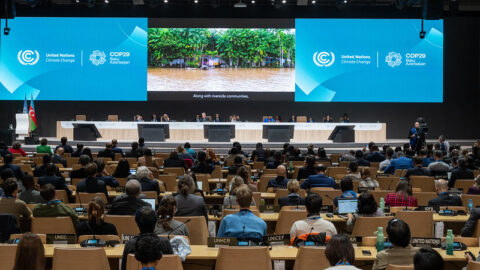At the end of May, the leaders of Australia’s fossil fuel extraction industry and their enablers in business and government descended on the Brisbane Convention Centre for the annual Australian Energy Producers (AEP) conference.
This time Greenpeace was there to send a message they couldn’t ignore: all members of this fossil fuel lobby group are complicit in fuelling the climate crisis. For companies claiming to support climate action, it’s time to cut ties with the AEP!
With an amazing team of volunteers, we covered the conference surrounds with posters, handed out hundreds of ‘Special Program Supplements’ as people entered the venue, decorated the bathroom mirrors with some cheeky slogans to force attendees to seriously  reflect
reflect , and had our message heard in the media too!
, and had our message heard in the media too!

(Keep scrolling for more photos)
And this is just the start.
Australian Energy Producers: the dodgiest fossil fuel lobby group you’ve never heard of
Though not a household name, Australian Energy Producers has an outsized influence on Australian politics. It is the peak body for the fossil fuel industry, comprising approximately 200 members who collectively produce around 95% of Australia’s oil and gas.
Since 1959, the AEP have actively opposed science-aligned climate policies that would control the pollution of the fossil fuel industry. Today, the group continues to aggressively advocate for dirty gas projects like Woodside’s North West Shelf and spend big on ad campaigns to influence public perception of fossil fuels.
Some of its members are the usual suspects: fossil fuel giants like Woodside, Shell, Santos, and Exxon-Mobil.
But you might be surprised to hear that not everyone in AEP are fossil fuel producers. Groups like UNSW, Curtin University, ANZ, PwC, EY, Deloitte and KPMG also hold membership in this profit-hungry group that lobbies for more dirty gas on their behalf.
Warning: If your company or university is a member of this fossil fuel lobby group, you are supporting a toxic industry and may even be at risk of legal action. Find out more
What did Greenpeace do at the AEP conference?
Instead of telling you exactly everything we did, why not put yourself in the shoes of the audience we hoped to reach with our creative interventions:
You work at an AEP member company like PwC and you’re on your way to the conference on Monday morning. Most of the time you feel pretty good about your job and your company. You’re proud of your company’s strong commitments to reaching net zero emissions and you brought your keep-cup to the event. As you search for the entrance your reflection catches you off guard on the opposite wall. It’s a Greenpeace poster embedded with a shiny mirror, calling the conference “a meeting of Australia’s biggest climate deniers.” You keep walking.
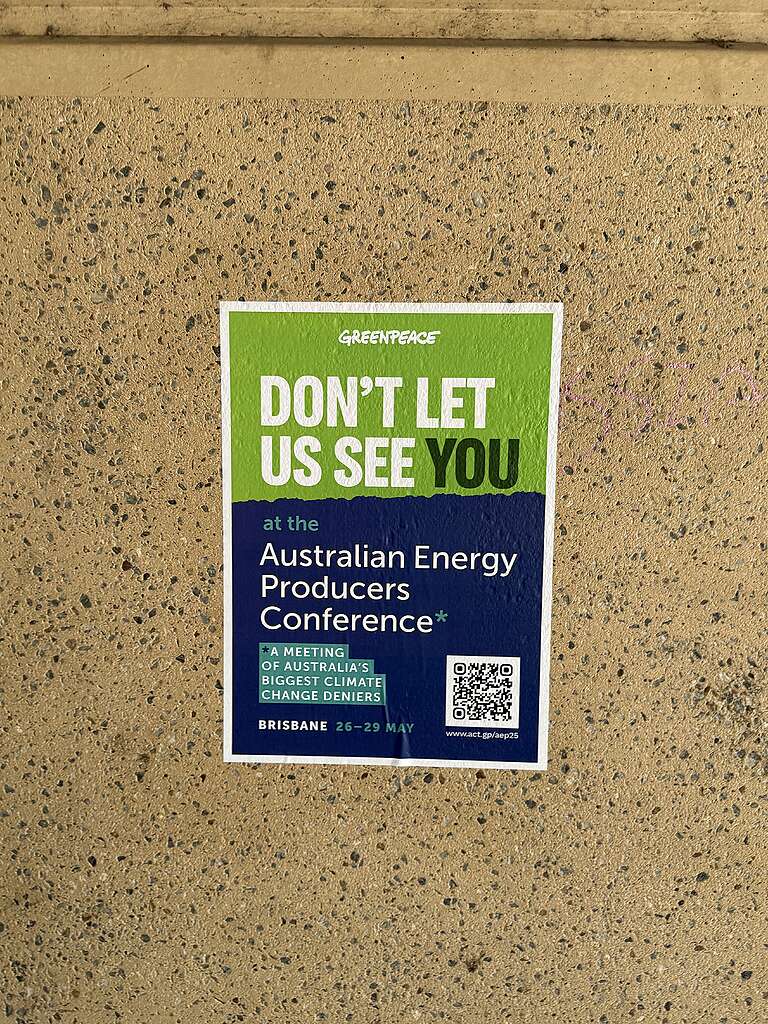
Later that day you check your LinkedIn App to see if any of your networking has paid off in new connection requests. *Sigh* only a post in your feed and a DM from Greenpeace with another dig about the fossil fuel lobby group.
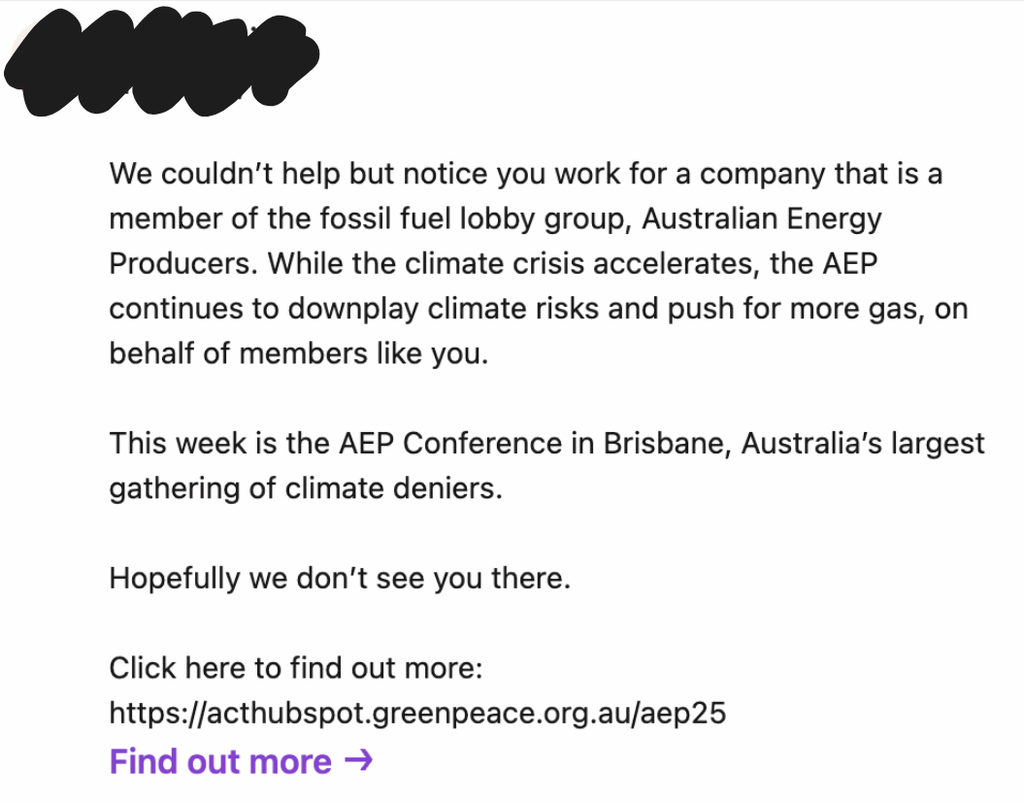
You start to feel a little uncomfortable.
Day 2:
A friendly volunteer with a suit and lanyard points you in the direction of the conference and offers you a Special Program Supplement. Great, you needed one of those!
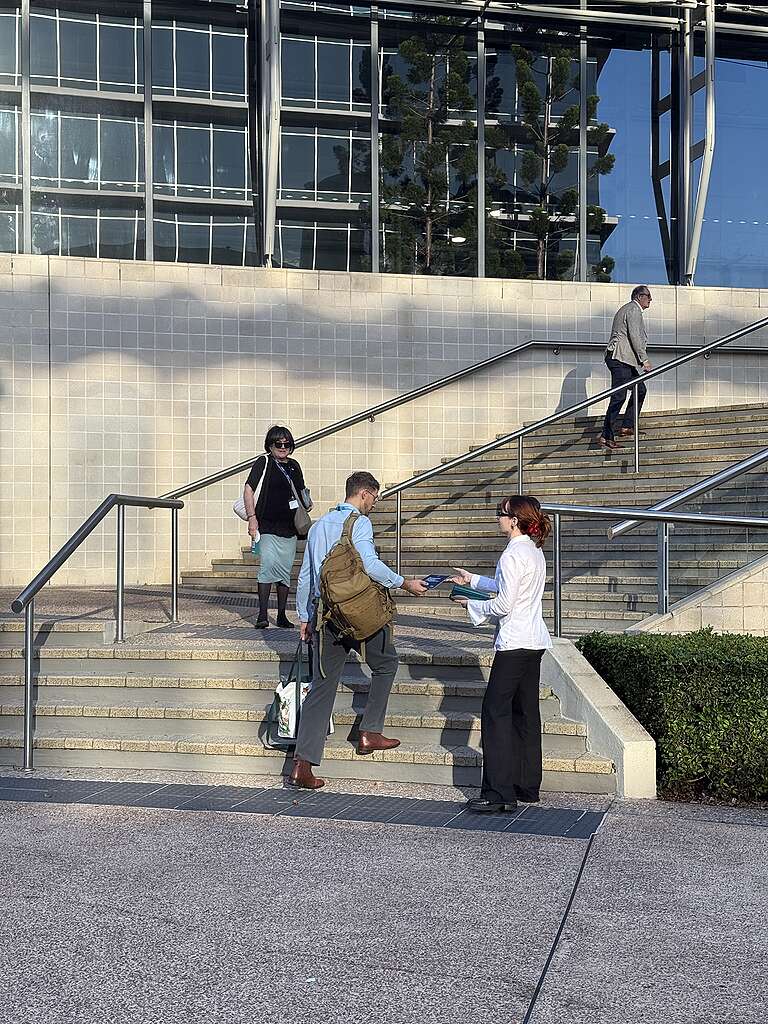
On your way into the first session you make a pit stop in the bathroom. Washing your hands afterwards you have to rub your eyes a few times to check if you’re starting to imagine things. Nope, it’s real. Right above your reflection is a sign clear as day “I’m the problem, it’s me.”

PwC isn’t the problem though…we do our part on climate, you think! But the words sound emptier than they did before.
Once inside you take your seat and open up the program supplement.
It reads: Australian Energy Producers is a fossil fuel lobby group who is fuelling climate change. And now we have found out who is really behind them…
YOU.
Just like Big Tobacco lied about cigarettes being safe, Big Gas is lying to you about fossil fuels. Drilling for more gas is incompatible with a safe climate.
The person to your right notices the mirror in your program and leans over to take a look. You both laugh it off and roll your eyes, but you’re starting to feel a bit sick. You reach into your bag to grab a notebook and notice another “I’m the problem sticker” that’s stuck between the pages.

You’d like to get out for some air. But Woodside CEO Meg O’Neil is on a tirade blaming young people for climate change and it would be an awkward moment to stand up. You clap politely instead.
Gas is a dirty fossil fuel driving dangerous climate change
In spite of the enormous advertising budgets used by Australian Energy Producers and many of its members to make gas seem ‘clean’ and ‘natural,’ gas is a polluting fossil fuel!!! Do we need to say it louder for the people in the back?
Coal, oil and gas account for over 75% of the global greenhouse gas emissions that are driving climate change. Gas is primarily made up of methane, which is even more polluting than carbon dioxide. When burned for energy, gas produces carbon dioxide. In Australia, gas accounts for at least 21% of carbon dioxide emissions. But methane and carbon dioxide also leak out into the atmosphere at every stage of gas production and transport, and tracking technology shows that more dangerous greenhouse gasses are released than are officially measured. When the processing and transportation of liquefied natural gas (LNG) are taken into account, there’s nothing “clean” about it: gas is a more polluting fossil fuel than coal.
New gas is incompatible with the world’s goal to limit warming to 1.5 degrees
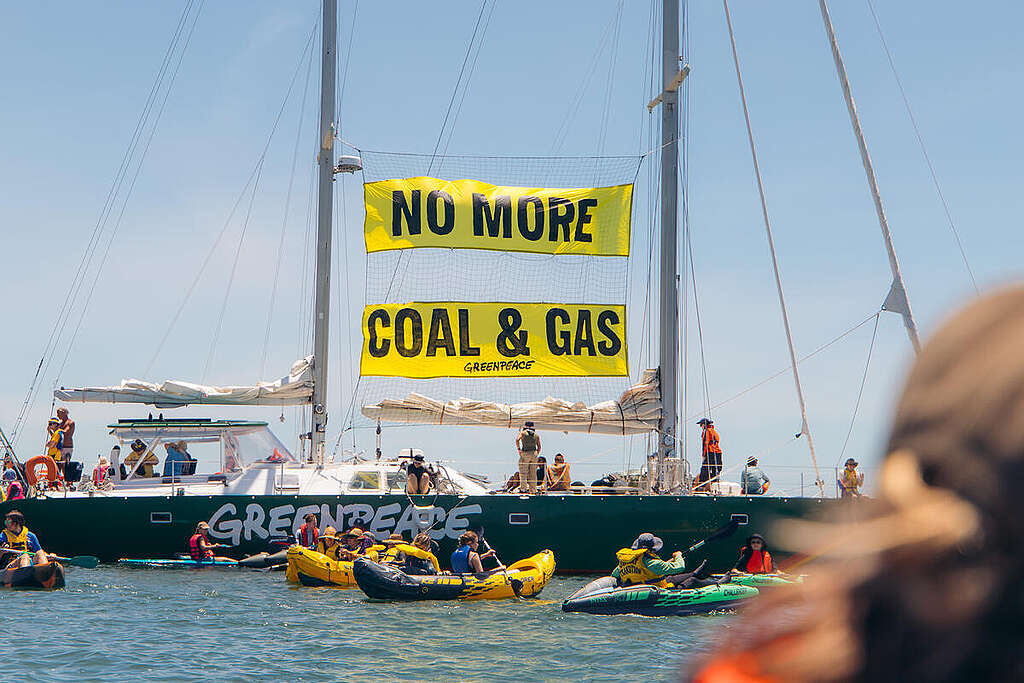
The protest sought to increase pressure on the Australian government to commit to a timeline for a fair and fast phase out away from all fossil fuels, starting with no more coal and gas.
Australia is the world’s third largest exporter of fossil fuels, and the Newcastle Port is the world’s largest coal export port. On the final day of the “protestival”, 170 people were arrested while out in their kayaks blocking the channel to prevent coal ships from passing, successfully forcing one coal ship to turn around.
While Australian Energy Producers like to say “we don’t get to net zero without natural gas” – and use this as justification for further gas expansion, the reality is we won’t get to net zero with new gas.
The International Energy Agency’s landmark Net Zero by 2050 report concluded that no new investment in oil, gas or coal is needed to reach net zero by 2050. Reaching net zero globally by 2050 is essential to limit global warming to 1.5C, in keeping with the Paris Agreement temperature goal – a legally binding international treaty on climate change which Australia is a Party to.
The Intergovernmental Panel on Climate Change has warned that existing fossil fuel projects could already push us past the 1.5C target. There is a large consensus that new oil and gas projects are fundamentally incompatible with the Paris Agreement, confirmed by the International Institute for Sustainable Development.The good news is, we don’t need to – as around 80% of Australia’s gas is currently exported, and demand for gas is falling domestically as we electrify everything and consumers look for alternatives because of high gas prices. And there is much more that can be done to reduce gas demand and power our homes and businesses with clean energy instead.
Time to quit Australian Energy Producers?
While climate change accelerates, Australian Energy Producers keep pushing fossil fuel interests. Claiming to support Net Zero while acting in ways that would make it impossible to attain simply doesn’t cut it in 2025.
Any company who is an Associate Member of AEP is complicit.
But if companies and universities want to stand on the right side of history, it’s not too late to cut ties with the AEP and cancel their membership.
We need everyone on board to support the renewable energy solutions that will power the clean transition and provide sustainable, well paid jobs, while we work together to keep fossil fuels in the ground.
Is your company an AEP member? Email us at Quit-AEP@greenpeace.org for more information on how you can raise this issue as an employee.
Not an AEP member but still concerned about its fossil fuel agenda? Sign the petition for no new fossil fuels!
Climate Change
Efforts to green lithium extraction face scrutiny over water use
Mining companies are showcasing new technologies which they say could extract more lithium – a key ingredient for electric vehicle (EV) batteries – from South America’s vast, dry salt flats with lower environmental impacts.
But environmentalists question whether the expensive technology is ready to be rolled out at scale, while scientists warn it could worsen the depletion of scarce freshwater resources in the region and say more research is needed.
The “lithium triangle” – an area spanning Argentina, Bolivia and Chile – holds more than half of the world’s known lithium reserves. Here, lithium is found in salty brine beneath the region’s salt flats, which are among some of the driest places on Earth.
Lithium mining in the region has soared, driven by booming demand to manufacture batteries for EVs and large-scale energy storage.
Mining companies drill into the flats and pump the mineral-rich brine to the surface, where it is left under the sun in giant evaporation pools for 18 months until the lithium is concentrated enough to be extracted.
The technique is relatively cheap but requires vast amounts of land and water. More than 90% of the brine’s original water content is lost to evaporation and freshwater is needed at different stages of the process.
One study suggested that the Atacama Salt Flat in Chile is sinking by up to 2 centimetres a year because lithium-rich brine is being pumped at a faster rate than aquifers are being recharged.
Lithium extraction in the region has led to repeated conflicts with local communities, who fear the impact of the industry on local water supplies and the region’s fragile ecosystem.
The lithium industry’s answer is direct lithium extraction (DLE), a group of technologies that selectively extracts the silvery metal from brine without the need for vast open-air evaporation ponds. DLE, it argues, can reduce both land and water use.
Direct lithium extraction investment is growing
The technology is gaining considerable attention from mining companies, investors and governments as a way to reduce the industry’s environmental impacts while recovering more lithium from brine.
DLE investment is expected to grow at twice the pace of the lithium market at large, according to research firm IDTechX.
There are around a dozen DLE projects at different stages of development across South America. The Chilean government has made it a central pillar of its latest National Lithium Strategy, mandating its use in new mining projects.
Last year, French company Eramet opened Centenario Ratones in northern Argentina, the first plant in the world to attempt to extract lithium solely using DLE.
Eramet’s lithium extraction plant is widely seen as a major test of the technology. “Everyone is on the edge of their seats to see how this progresses,” said Federico Gay, a lithium analyst at Benchmark Mineral Intelligence. “If they prove to be successful, I’m sure more capital will venture into the DLE space,” he said.
More than 70 different technologies are classified as DLE. Brine is still extracted from the salt flats but is separated from the lithium using chemical compounds or sieve-like membranes before being reinjected underground.
DLE techniques have been used commercially since 1996, but only as part of a hybrid model still involving evaporation pools. Of the four plants in production making partial use of DLE, one is in Argentina and three are in China.
Reduced environmental footprint
New-generation DLE technologies have been hailed as “potentially game-changing” for addressing some of the issues of traditional brine extraction.
“DLE could potentially have a transformative impact on lithium production,” the International Lithium Association found in a recent report on the technology.
Firstly, there is no need for evaporation pools – some of which cover an area equivalent to the size of 3,000 football pitches.
“The land impact is minimal, compared to evaporation where it’s huge,” said Gay.
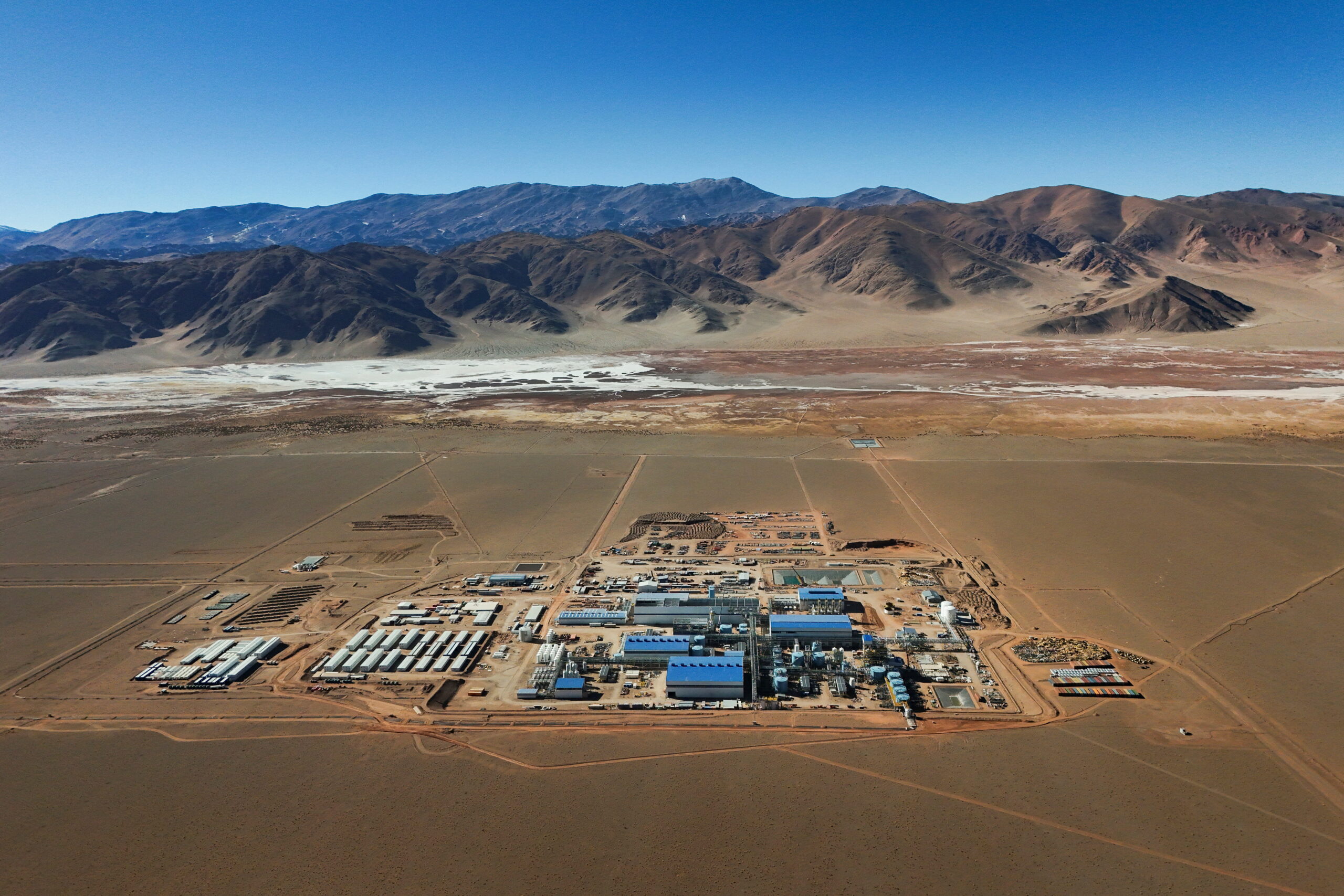

The process is also significantly quicker and increases lithium recovery. Roughly half of the lithium is lost during evaporation, whereas DLE can recover more than 90% of the metal in the brine.
In addition, the brine can be reinjected into the salt flats, although this is a complicated process that needs to be carefully handled to avoid damaging their hydrological balance.
However, Gay said the commissioning of a DLE plant is currently several times more expensive than a traditional lithium brine extraction plant.
“In theory it works, but in practice we only have a few examples,” Gay said. “Most of these companies are promising to break the cost curve and ramp up indefinitely. I think in the next two years it’s time to actually fulfill some of those promises.”
Freshwater concerns
However, concerns over the use of freshwater persist.
Although DLE doesn’t require the evaporation of brine water, it often needs more freshwater to clean or cool equipment.
A 2023 study published in the journal Nature reviewed 57 articles on DLE that analysed freshwater consumption. A quarter of the articles reported significantly higher use of freshwater than conventional lithium brine mining – more than 10 times higher in some cases.
“These volumes of freshwater are not available in the vicinity of [salt flats] and would even pose problems around less-arid geothermal resources,” the study found.
The company tracking energy transition minerals back to the mines
Dan Corkran, a hydrologist at the University of Massachusetts, recently published research showing that the pumping of freshwater from the salt flats had a much higher impact on local wetland ecosystems than the pumping of salty brine. “The two cannot be considered equivalent in a water footprint calculation,” he said, explaining that doing so would “obscure the true impact” of lithium extraction.
Newer DLE processes are “claiming to require little-to-no freshwater”, he added, but the impact of these technologies is yet to be thoroughly analysed.
Dried-up rivers
Last week, Indigenous communities from across South America held a summit to discuss their concerns over ongoing lithium extraction.
The meeting, organised by the Andean Wetlands Alliance, coincided with the 14th International Lithium Seminar, which brought together industry players and politicians from Argentina and beyond.
Indigenous representatives visited the nearby Hombre Muerto Salt Flat, which has borne the brunt of nearly three decades of lithium extraction. Today, a lithium plant there uses a hybrid approach including DLE and evaporation pools.
Local people say the river “dried up” in the years after the mine opened. Corkran’s study linked a 90% reduction in wetland vegetation to the lithium’s plant freshwater extraction.
Pia Marchegiani, of Argentine environmental NGO FARN, said that while DLE is being promoted by companies as a “better” technique for extraction, freshwater use remained unclear. “There are many open questions,” she said.
AI and satellite data help researchers map world’s transition minerals rush
Stronger regulations
Analysts speaking to Climate Home News have also questioned the commercial readiness of the technology.
Eramet was forced to downgrade its production projections at its DLE plant earlier this year, blaming the late commissioning of a crucial component.
Climate Home News asked Eramet for the water footprint of its DLE plant and whether its calculations excluded brine, but it did not respond.
For Eduardo Gigante, an Argentina-based lithium consultant, DLE is a “very promising technology”. But beyond the hype, it is not yet ready for large-scale deployment, he said.
Strong regulations are needed to ensure that the environmental impact of the lithium rush is taken seriously, Gigante added.
In Argentina alone, there are currently 38 proposals for new lithium mines. At least two-thirds are expected to use DLE. “If you extract a lot of water without control, this is a problem,” said Gigante. “You need strong regulations, a strong government in order to control this.”
The post Efforts to green lithium extraction face scrutiny over water use appeared first on Climate Home News.
Efforts to green lithium extraction face scrutiny over water use
Climate Change
Maryland’s Conowingo Dam Settlement Reasserts State’s Clean Water Act Authority but Revives Dredging Debate
The new agreement commits $340 million in environmental investments tied to the Conowingo Dam’s long-term operation, setting an example of successful citizen advocacy.
Maryland this month finalized a $340 million deal with Constellation Energy to relicense the Conowingo Dam in Cecil County, ending years of litigation and regulatory uncertainty. The agreement restores the state’s authority to enforce water quality standards under the Clean Water Act and sets a possible precedent for dozens of hydroelectric relicensing cases nationwide expected in coming years.
Climate Change
A Michigan Town Hopes to Stop a Data Center With a 2026 Ballot Initiative
Local officials see millions of dollars in tax revenue, but more than 950 residents who signed ballot petitions fear endless noise, pollution and higher electric rates.
This is the second of three articles about Michigan communities organizing to stop the construction of energy-intensive computing facilities.
A Michigan Town Hopes to Stop a Data Center With a 2026 Ballot Initiative
-
Climate Change2 years ago
Spanish-language misinformation on renewable energy spreads online, report shows
-
Climate Change2 months ago
Guest post: Why China is still building new coal – and when it might stop
-
Climate Change Videos2 years ago
The toxic gas flares fuelling Nigeria’s climate change – BBC News
-

 Greenhouse Gases1 year ago
Greenhouse Gases1 year ago嘉宾来稿:满足中国增长的用电需求 光伏加储能“比新建煤电更实惠”
-
Greenhouse Gases2 months ago
Guest post: Why China is still building new coal – and when it might stop
-

 Climate Change1 year ago
Climate Change1 year ago嘉宾来稿:满足中国增长的用电需求 光伏加储能“比新建煤电更实惠”
-

 Carbon Footprint2 years ago
Carbon Footprint2 years agoUS SEC’s Climate Disclosure Rules Spur Renewed Interest in Carbon Credits
-
Renewable Energy3 months ago
US Grid Strain, Possible Allete Sale


